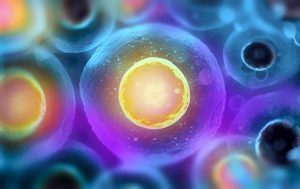Discipline-Hopping: UK Law and Emerging Reproductive Technologies
By Dr Zoe Bolton, published 4th August 2023
What role has law played in controlling new human reproductive technologies and what role should it play in the future? These are the key questions that The Future of Human Reproduction team set out to explore in a discipline-hopping, law taster workshop facilitated by Professor Sara Fovargue and Dr Laura O’Donovan.
Case history: when is an embryo not an embryo?
 The focus of the workshop was a case from 2001 where Bruno Quintavalle, on behalf of the Pro-Life Alliance, brought a legal challenge against the Secretary of State for Health arguing that human embryos created by Cell Nuclear Replacement (CNR) were outside of the scope of the Human Fertilisation and Embryology Act 1990.
The focus of the workshop was a case from 2001 where Bruno Quintavalle, on behalf of the Pro-Life Alliance, brought a legal challenge against the Secretary of State for Health arguing that human embryos created by Cell Nuclear Replacement (CNR) were outside of the scope of the Human Fertilisation and Embryology Act 1990.
CNR is a form of cloning where the nucleus from an adult body (somatic) cell is transplanted into an enucleated unfertilised egg (one from which the nucleus has been removed) to create a viable embryo. It is also known as Somatic Cell Nuclear Transfer (SCNT) and, most famously, was used to create Dolly the Sheep. When the 1990 Act was drafted, CNR was not scientifically possible, and would not become so until 1997. Hence, it had not been explicitly accounted for in the Act.
Quintavalle claimed that, because CNR does not involve fertilisation, an embryo created by CNR does not fall within the legal definition of ‘embryo’ in the 1990 Act, which is that ‘embryo means a live human embryo where fertilisation is complete’ (s 1(1)(a)). On the basis of this claim, Quintavalle was granted a judicial review.
Applying the ‘literal rule’ of statutory interpretation – according to which the words of an Act are considered to have their ordinary or natural meanings – High Court judge, Mr Justice Crane, agreed with Quintavalle and ruled that an organism created by CNR was not an embryo within the definition of the Act ([2001] WL 1347031). This ruling had the serious consequence of leaving CNR outside of statutory and regulatory control, making it legally permissible for scientists in the UK to attempt human cloning.
In response, the UK Government hastily introduced the Human Reproductive Cloning Act 2001 to close this loophole. The 2001 Act made it an offence to place a human embryo in a woman, unless it had been created by fertilisation. Mr Justice Crane’s ruling was then subsequently overturned by the Court of Appeal in 2002 ([2002] Q.B. 628), with the House of Lords (the equivalent of The Supreme Court at that time) also unanimously upholding the Court of Appeal’s ruling in 2003 ([2003] UKHL 13). Both the Court of Appeal and the House of Lords applied a purposive approach to statutory interpretation, which allows Parliament’s intentions at the time when the Act was enacted to be taken into account.
Understanding law in England and Wales
 To help the non-experts in the room understand this complex legal case, the workshop began with a brief introduction to law in England and Wales. This helpfully explained the court structure, the respective roles of the law and of Parliament, and the remit of judicial review.
To help the non-experts in the room understand this complex legal case, the workshop began with a brief introduction to law in England and Wales. This helpfully explained the court structure, the respective roles of the law and of Parliament, and the remit of judicial review.
Understanding the court structure established a hierarchy for the three judgments (High Court, Court of Appeal, House of Lords) that the team had read in advance of the workshop and facilitated an understanding of the legal appeals process. Recognising that Parliament is the supreme legal authority in England and Wales (the principle of parliamentary sovereignty) and that the role of the courts is to interpret and apply the law enacted by Parliament, also helped to make sense of some of the conjecture in the judgments about what the law could and could not do in the Quintavalle case.
For example, the judgment of Mr Justice Crane contains a whole section about the authority and role of the court and concludes that it should exercise jurisdiction because Quintavalle ‘raised a legitimate concern about the meaning of section 1’ of the 1990 Act. Similarly, the Court of Appeal judgment makes clear its role in the process: ‘We are not able to ask: what would Parliament have done or said in this current case if the new facts had been before it? Rather, we are to interpret the words which Parliament did in fact use in the context of the new facts that have now come to light’. Such approaches are within the remit of the courts’ power, which allows judges to interpret statutory law but not to change it. Changes to statute can only be made by Parliament either by primary legislation, an Act passed by Parliament, or secondary legislation, whereby ministers use powers granted to them under the primary legislation to provide the detail needed for that legislation to operate and be effective in practice.
‘Like reading something written in a foreign language’ Following on from the introduction to UK law, team members were asked to discuss their reactions to the judgments. This sparked a lively discussion, with very different opinions about the material being expressed by those in the room. Some team members found the judgments ‘boring’, ‘pompous’ and ‘inaccessible’ because of the tone and technical details – with one team member describing their experience of the judgments as ‘like reading something written in a foreign language’. In contrast, others thought the judgments gave a fascinating insight into the process of the law and found that the logical structure of the arguments and repetition supported their understanding of the case.
Following on from the introduction to UK law, team members were asked to discuss their reactions to the judgments. This sparked a lively discussion, with very different opinions about the material being expressed by those in the room. Some team members found the judgments ‘boring’, ‘pompous’ and ‘inaccessible’ because of the tone and technical details – with one team member describing their experience of the judgments as ‘like reading something written in a foreign language’. In contrast, others thought the judgments gave a fascinating insight into the process of the law and found that the logical structure of the arguments and repetition supported their understanding of the case.
A broader question was also raised during the discussion about the reasons for Quintavalle bringing the case in the first place: when the Pro-Life Alliance is against cloning and embryo research why would it take legal action that could, and did, result in CNR falling outside statutory and regulatory control? This question was also raised by counsel for the Secretary of State in the High Court, who concluded that the aim was to force issues of cloning and embryo research back onto the parliamentary agenda. This prompted further discussion in the workshop about whether so much time and money should have been spent debating a claim that hinged around four words, ‘where fertilisation is complete’, in the 1990 Act.
In terms of the team’s thoughts on the decisions themselves, there was general agreement that, given the significant consequences of Mr Justice’s Crane’s ruling, his literal interpretation of the statute was problematic, and that there was a compelling argument for the purposive approach taken by the Court of Appeal and the House of Lords, which brought CNR back within the statutory and regulatory framework. This led to further discussion about whether the current law was fit for purpose in terms of legislating for future reproductive technologies and about the efficiency of the legal process when challenges to Parliamentary legislation arise.
Legislating for future technologies
The 1990 Act was amended in 2008 and section 1(1) was broadened to include the ‘meaning of “embryo”, “gamete” and associated expressions’. However, future advances in human reproductive biotechnologies such as in vitro-derived gametes (artificially created eggs and sperm) and human stem cell based embryo models (SCBEMs), are not currently explicitly covered by the amended definitions of the Act. It is the legal issues raised by these future biotechnologies that formed the final part of the workshop.
Team members were asked to work in groups and either to draft new legislation or to revise the definitions in the current Act to take account of these technologies. In the feedback session that followed, both teams opted to rewrite the definition in the Act and offered the following two amendments: ‘an embryo or biologically functional identical entity’; ‘a live human embryo or embryo-like entity derived from human cells’.
There was general agreement that in vitro-derived gametes and SCBEMs should be brought under the umbrella of the current 1990 Act (as amended in 2008) and that amendments to that Act should include a revised definition and a maximum time limit for research on those entities. This would, the team felt, strike a balance between enabling, and licensing, responsible scientific research that could lead to important developments in the treatment of infertility and hereditary diseases, while protecting against possible misuse.
 The discussion then turned to the question of whether the Act should be re-opened to allow for these amendments under primary legislation, or whether it would be preferable to opt for secondary legislation which delegated authority to a minister to amend some parts of the Act. It was agreed that the latter would be the most effective approach given the timescales involved in reopening an Act within the parliamentary schedule and the urgent need to futureproof current legislation against biotechnological advances. This was not just a hypothetical discussion because, at the time of the workshop, the Human Fertilisation and Embryologic Authority (HFEA) had launched a consultation on changes to the 1990 Act (as amended in 2008) and sought specific feedback on futureproofing the Act against future scientific developments.
The discussion then turned to the question of whether the Act should be re-opened to allow for these amendments under primary legislation, or whether it would be preferable to opt for secondary legislation which delegated authority to a minister to amend some parts of the Act. It was agreed that the latter would be the most effective approach given the timescales involved in reopening an Act within the parliamentary schedule and the urgent need to futureproof current legislation against biotechnological advances. This was not just a hypothetical discussion because, at the time of the workshop, the Human Fertilisation and Embryologic Authority (HFEA) had launched a consultation on changes to the 1990 Act (as amended in 2008) and sought specific feedback on futureproofing the Act against future scientific developments.
To return to the key questions under discussion at the workshop – what role has law played in controlling new human reproductive technologies and what role should it play in the future? – the broad conclusions were that, while the law is vitally important to ensuring effective regulation of reproductive technologies, it is often not able to respond quickly enough to legislate effectively for advances in those technologies. This is, in essence, why a case like the one brought by Quintavalle was possible. It was agreed that any changes to the 1990 Act (as amended in 2008), whether via primary or secondary legislation should be futureproofed so that the law is better able to respond and adapt to scientific and technological innovation. How that futureproofing might occur in practice, is still open for discussion.
Other Posts
- Six Things You Should Know About IVG
- The Future of Artificial Placenta Technology: Should we Proceed with Caution?
- “The genetics bomb could be a disaster”: Author Simon Mawer on Mendel’s Dwarf
- Spotlight on CRISPR-Cas9
- Exhibition Review: Genetic Automata
- A Look Back at 2023
- Explainer: Human Stem Cell Based Embryo Models
- Is it time to revisit the 14-day rule?
- Gifting the Womb: The UK’s First Uterus Transplantation
- Reflections: A Look Back at the First Year of the Project
- Book Review – Eve: The Disobedient Future of Birth
- Ectogenesis: A Retrospective
